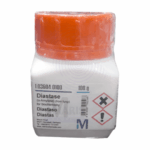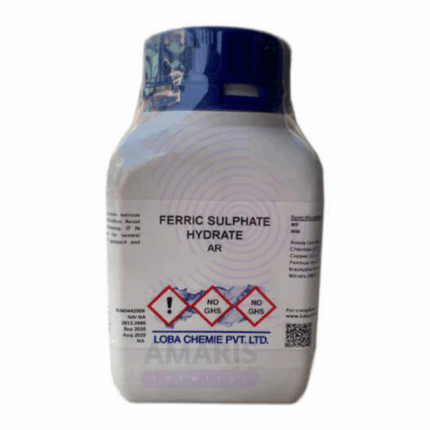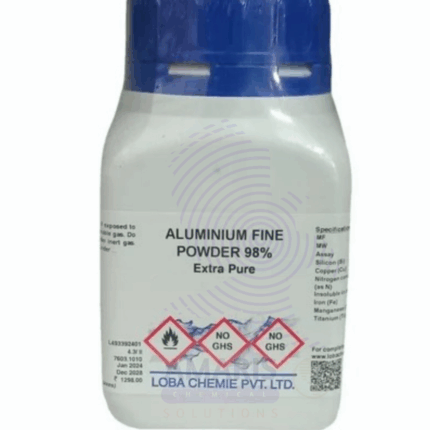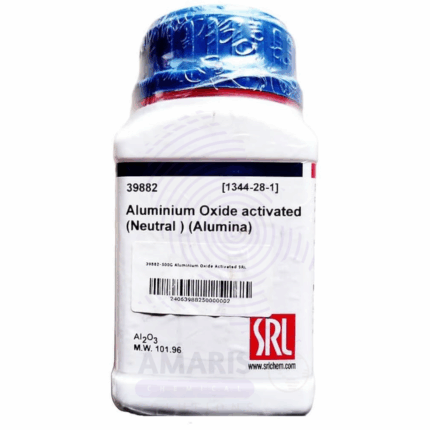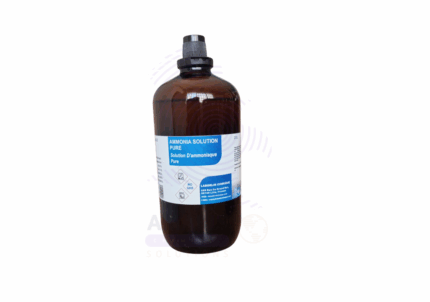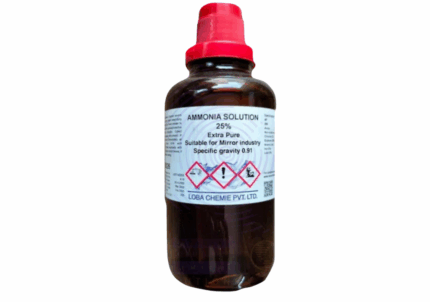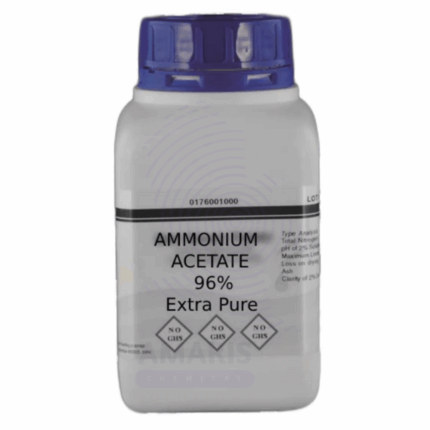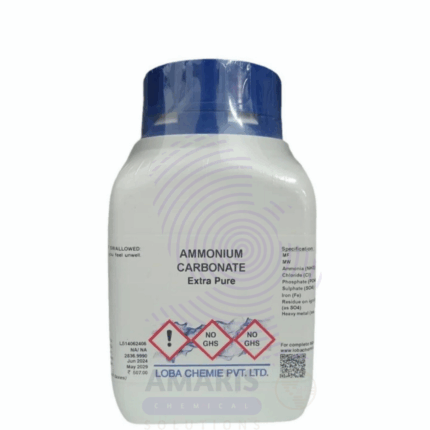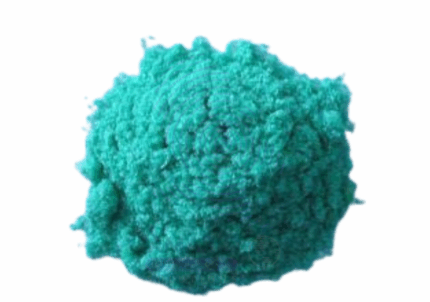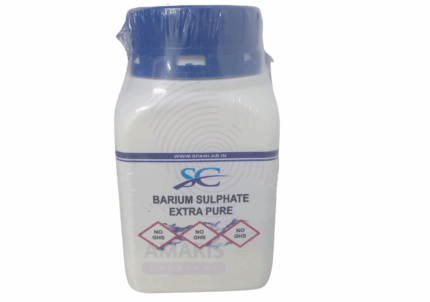Dextrose Monohydrate Extra Pure
$ 17.50 Original price was: $ 17.50.$ 17.34Current price is: $ 17.34.
Dextrose Monohydrate Extra Pure is a high-purity crystalline form of glucose containing one molecule of water. It is widely used in laboratory settings as a carbon source in microbial culture media, fermentation processes, and biochemical assays. Its precise composition and consistent solubility make it ideal for preparing nutrient solutions, buffers, and test reagents. In research and educational labs, it supports various metabolic and enzymatic studies. This extra pure grade ensures minimal impurities, providing reliable results in sensitive analytical and biological applications. Store in a tightly sealed container in a cool, dry place to preserve its quality and prevent clumping.
Dextrose Monohydrate Extra Pure
Primary Uses
- Microbiology Media Component
- Serves as a carbon and energy source in culture media for bacteria, fungi, and yeast growth.
- Fermentation Experiments
- Common substrate for fermentation studies and metabolic pathway analysis, particularly in biochemistry labs.
- Biochemical Reagent
- Used in assays involving enzymes like glucose oxidase, or calorimetric glucose detection methods.
- Osmotic Balance in Solutions
- Added to buffers or solutions to maintain osmotic pressure, especially in cell-based assays or perfusion systems.
Secondary Uses
- Standard in Analytical Chemistry
- Used to calibrate or validate sugar quantification methods (e.g., Fehling’s, Benedict’s, DNS assays).
- Model Compound for Carbohydrate Studies
- Helpful in exploring reducing sugar behavior, Maillard reactions, or starch hydrolysis experiments.
- Cryoprotectant Component
- Part of cryopreservation mixtures to protect cells or enzymes during freezing.
| PACK SIZE |
500 grams Plastic Tin |
|---|
1. Basic Identification Attributes
- Chemical Name: Dextrose Monohydrate
- Other Names: Glucose Monohydrate, D-Glucose Monohydrate
- CAS Number: 14431-43-7
- Chemical Formula: C₆H₁₂O₆·H₂O
- Molar Mass: 198.17 g/mol
- Grade: Extra Pure (Laboratory Grade)
2. Physical & Chemical Properties
- Appearance: White, crystalline powder or granules
- Odor: Odorless
- Taste: Sweet
- Solubility: Freely soluble in water; slightly soluble in ethanol
- Melting Point: ~83 °C (decomposes)
- pH (5% solution): 4.0 – 6.5
- Hygroscopicity: Hygroscopic (absorbs moisture from air)
3. Safety & Hazard Attributes
- GHS Classification: Not classified as hazardous
- NFPA Ratings:
- Health: 0
- Flammability: 1
- Reactivity: 0
- First Aid Measures:
- Inhalation: Move to fresh air
- Skin Contact: Wash with soap and water
- Eye Contact: Rinse thoroughly with water
- Ingestion: Non-toxic in typical lab quantities; rinse mouth if needed
4. Storage & Handling Attributes
- Storage Conditions:
- Store in a cool, dry, and well-ventilated area
- Keep container tightly closed to prevent clumping due to moisture
- Use desiccator if necessary
- Handling Advice:
- Avoid inhalation of dust
- Use clean tools to avoid contamination
- Wash hands after handling
5. Regulatory & Compliance Attributes
- EINECS Number: 200-075-1
- UN Number: Not regulated
- REACH Status: Exempt (naturally occurring sugar)
6. Applications in Laboratory
- Primary Use:
- Used as a nutrient in microbiological media and fermentation
- Other Uses:
- Carbon source in cell culture and biochemical research
- Reducing sugar in Benedict’s and Fehling’s tests
- Analytical chemistry (as a standard sugar)
- Used in pharmaceutical formulations and reagent buffers
- Calibration of polarimeters
SAFETY PRECAUTIONS
- PPE:
- Lab coat
- Safety goggles
- Gloves (especially when handling in large quantities or preparing solutions)
- Handling Notes:
- Avoid creating dust—use in well-ventilated areas
- Keep away from moisture to maintain stability
- Storage Conditions:
- Store in a cool, dry place
- Keep container tightly sealed
- Hygroscopic – protect from humidity and direct sunlight
FIRST AID MEASURES
- Inhalation: Move to fresh air; seek medical help if irritation persists
- Skin Contact: Wash with water; no significant hazard
- Eye Contact: Rinse cautiously with water for several minutes
- Ingestion: Generally low toxicity, but lab-grade material should not be consumed
FIREFIGHTING MEASURES
- Flammability: Combustible as a powder
- Hazards: May form explosive dust-air mixtures
- Extinguishing Media: Water spray, foam, dry chemical, or CO₂
- Special Notes: Avoid stirring up dust near open flames
Related products
Aluminium Ferric Sulphate Extra Pure
Aluminium Metal Fine Extra Pure
Aluminium Oxide Active Neutral Extra Pure
Ammonia Solution Extra Pure
Ammonium Acetate Extra Pure
Ammonium Carbonate Extra Pure
Ammonium Carbonate Extra Pure is a high-quality, white crystalline solid widely used across various scientific, industrial, and food-related applications. Manufactured to stringent purity standards, this compound is ideal for laboratories and processes that demand high-grade reagents. With its characteristic ammonia-like odor and ability to decompose upon heating, ammonium carbonate plays a versatile role in both chemical reactions and physical processes.
In aqueous solution, ammonium carbonate breaks down into ammonium bicarbonate and ammonium carbamate, further releasing ammonia (NH₃) and carbon dioxide (CO₂) upon heating. This property makes it especially useful in applications that require controlled gas release or temporary pH modification.


 Preservatives(food)
Preservatives(food) Flavor Enhancers
Flavor Enhancers Acidulants
Acidulants Sweeteners
Sweeteners Antioxidants
Antioxidants Colorants(food)
Colorants(food) Nutraceutical Ingredients (food)
Nutraceutical Ingredients (food) Nutrient Supplements
Nutrient Supplements Emulsifiers
Emulsifiers
 Collectors
Collectors Dust Suppressants
Dust Suppressants Explosives and Blasting Agents
Explosives and Blasting Agents Flocculants and Coagulants
Flocculants and Coagulants Frothers
Frothers Leaching Agents
Leaching Agents pH Modifiers
pH Modifiers Precious Metal Extraction Agents
Precious Metal Extraction Agents
 Antioxidants(plastic)
Antioxidants(plastic) Colorants (Pigments, Dyes)
Colorants (Pigments, Dyes) Fillers and Reinforcements
Fillers and Reinforcements Flame Retardants
Flame Retardants Monomers
Monomers Plasticizers
Plasticizers Polymerization Initiators
Polymerization Initiators Stabilizers (UV, Heat)
Stabilizers (UV, Heat)
 Antifoaming Agents
Antifoaming Agents Chelating Agents
Chelating Agents Coagulants and Flocculants
Coagulants and Flocculants Corrosion Inhibitors
Corrosion Inhibitors Disinfectants and Biocides
Disinfectants and Biocides Oxidizing Agents
Oxidizing Agents pH Adjusters
pH Adjusters Scale Inhibitors( water)
Scale Inhibitors( water)
 Antioxidants(cosmetic)
Antioxidants(cosmetic) Emollients
Emollients Fragrances and Essential Oils
Fragrances and Essential Oils Humectants
Humectants Preservatives
Preservatives Surfactants(cosmetic)
Surfactants(cosmetic) Thickeners
Thickeners UV Filters
UV Filters
 Fertilizers
Fertilizers Soil Conditioners
Soil Conditioners Plant Growth Regulators
Plant Growth Regulators Animal Feed Additives
Animal Feed Additives Biostimulants
Biostimulants Pesticides (Herbicides, Insecticides, Fungicides)
Pesticides (Herbicides, Insecticides, Fungicides)
 Active Pharmaceutical Ingredients (APIs)
Active Pharmaceutical Ingredients (APIs) Excipients
Excipients Solvents(pharmaceutical)
Solvents(pharmaceutical) Antibiotics
Antibiotics Antiseptics and Disinfectants
Antiseptics and Disinfectants Vaccine Adjuvants
Vaccine Adjuvants Nutraceutical Ingredients (pharmaceutical)
Nutraceutical Ingredients (pharmaceutical) Analgesics & Antipyretics
Analgesics & Antipyretics
 Analytical Reagents
Analytical Reagents Solvents(lab)
Solvents(lab) Chromatography Chemicals
Chromatography Chemicals Spectroscopy Reagents
Spectroscopy Reagents microbiology-and-cell-culture-reagents
microbiology-and-cell-culture-reagents Molecular Biology Reagents
Molecular Biology Reagents Biochemical Reagents
Biochemical Reagents Inorganic and Organic Standards
Inorganic and Organic Standards Laboratory Safety Chemicals
Laboratory Safety Chemicals Specialty Laboratory Chemicals(Special Laboratory Equipment)
Specialty Laboratory Chemicals(Special Laboratory Equipment)
 Demulsifiers
Demulsifiers Hydraulic Fracturing Fluids
Hydraulic Fracturing Fluids Scale Inhibitors(oil)
Scale Inhibitors(oil) Surfactants(oil)
Surfactants(oil) Drilling Fluids
Drilling Fluids
 Dyes and Pigments
Dyes and Pigments Bleaching Agents
Bleaching Agents Softening Agents
Softening Agents Finishing Agents
Finishing Agents Antistatic Agents
Antistatic Agents
 Admixtures
Admixtures Waterproofing Agents
Waterproofing Agents Sealants and Adhesives
Sealants and Adhesives Curing Compounds
Curing Compounds Concrete Repair Chemicals
Concrete Repair Chemicals Anti-Corrosion Coatings
Anti-Corrosion Coatings
 Surfactants(cleaning)
Surfactants(cleaning) Builders
Builders Enzymes
Enzymes Solvents (Cleaning)
Solvents (Cleaning) Fragrances
Fragrances
 Electronic Chemicals
Electronic Chemicals Catalysts
Catalysts Lubricants
Lubricants Photographic Chemicals
Photographic Chemicals Refrigerants
Refrigerants Automotive chemicals
Automotive chemicals Pyrotechnic Chemicals
Pyrotechnic Chemicals
 Biodegradable Surfactants
Biodegradable Surfactants Bio-based Solvents
Bio-based Solvents Renewable Polymers
Renewable Polymers Carbon Capture Chemicals
Carbon Capture Chemicals Wastewater Treatment Chemicals
Wastewater Treatment Chemicals
 Pigments
Pigments Solvents(paint)
Solvents(paint) Specialty Coatings
Specialty Coatings Binders/Resins
Binders/Resins Additives
Additives Driers
Driers Anti-Corrosion Agents
Anti-Corrosion Agents Functional Coatings
Functional Coatings Application-Specific Coatings
Application-Specific Coatings
 Fresh Herbs
Fresh Herbs Ground Spices
Ground Spices Whole Spices
Whole Spices Spice Blends
Spice Blends Dried Herbs
Dried Herbs
 Leavening Agents
Leavening Agents Dough Conditioners
Dough Conditioners Flour Treatments
Flour Treatments Fat Replacers
Fat Replacers Decoratives
Decoratives Preservatives(baking)
Preservatives(baking)
 Plasticizers & Softeners
Plasticizers & Softeners Reinforcing Agents
Reinforcing Agents Adhesion Promoters
Adhesion Promoters Vulcanizing Agents
Vulcanizing Agents Antidegradants
Antidegradants Blowing Agents
Blowing Agents Fillers & Extenders
Fillers & Extenders Accelerators & Retarders
Accelerators & Retarders

